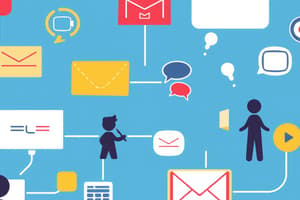Podcast
Questions and Answers
What is the primary difference between print media and digital media?
What is the primary difference between print media and digital media?
- Print media is more expensive to produce, while digital media is more cost-effective.
- Print media is less accessible, while digital media is more widely available. (correct)
- Print media has a wider reach, while digital media is more targeted.
- Print media is more permanent, while digital media is more ephemeral.
Which type of media has been the primary source of news and entertainment for many people?
Which type of media has been the primary source of news and entertainment for many people?
- Print media
- Broadcast media (correct)
- Digital media
- All of the above
Which of the following is a characteristic of print media?
Which of the following is a characteristic of print media?
- Instant accessibility
- Widespread reach (correct)
- Ephemeral nature
- Ability to be easily updated
Which type of media has been most impacted by the rise of digital technology?
Which type of media has been most impacted by the rise of digital technology?
What is the primary advantage of digital media over print media?
What is the primary advantage of digital media over print media?
Which of the following is a key characteristic of broadcast media?
Which of the following is a key characteristic of broadcast media?
What does the term 'convergent media' refer to?
What does the term 'convergent media' refer to?
What is the primary benefit of developing media and information literacy skills?
What is the primary benefit of developing media and information literacy skills?
How does the text describe the relationship between media and society?
How does the text describe the relationship between media and society?
What is one of the key skills needed to navigate the evolving media landscape?
What is one of the key skills needed to navigate the evolving media landscape?
How does the text describe the current state of media and information literacy?
How does the text describe the current state of media and information literacy?
What is the primary purpose of the text?
What is the primary purpose of the text?
Flashcards are hidden until you start studying
Study Notes
The Importance of Media and Information Literacy
In today's digital age, media and information literacy have become crucial skills for individuals to navigate the vast amount of information available. These skills enable people to analyze, evaluate, create, and act upon media and information from a variety of sources. Let's explore the different types of media and how they influence our understanding of these vital competencies.
Types of Media
The term 'media' encompasses various platforms through which we receive and share information. Some common forms of media include:
Print Media
Print media refers to traditional written material such as newspapers, magazines, and books. While these sources are still widely used and can provide valuable insights, their reach has been somewhat overshadowed by digital forms of media.
Broadcast Media
Broadcast media, including television, radio, and films, have traditionally been the primary sources of news and entertainment for many people. However, the rise of digital media has led to changes in how these platforms are accessed and consumed.
Digital Media
Digital media, such as websites, social media platforms, and apps, have revolutionized the way information is shared and consumed. The ease of access and the sheer volume of content available make it essential for individuals to develop media and information literacy skills to navigate this landscape effectively.
Convergent Media
Convergent media refers to the integration of various media forms into one platform. A prime example is YouTube, where users can watch television shows, listen to podcasts, and access a wealth of written content within a single app.
Developing Media and Information Literacy Skills
As media continues to evolve and expand, it becomes increasingly important for individuals to develop media and information literacy skills. This includes being able to identify and evaluate the credibility of sources, understand the impact of media on society, and create and disseminate accurate information responsibly.
In conclusion, media and information literacy are indispensable skills in our rapidly changing world. By understanding the various types of media available, we can better recognize how each form contributes to our knowledge and awareness. As we continue to grapple with the potential consequences of misinformation and disinformation, developing media and information literacy skills will equip us to make informed decisions and contribute positively to our communities.
Studying That Suits You
Use AI to generate personalized quizzes and flashcards to suit your learning preferences.




